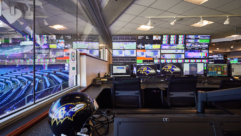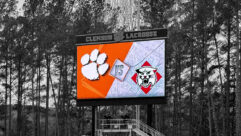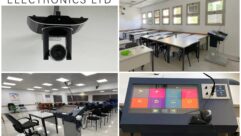
Baltimore Ravens Outfit New Training Facility with Panasonic Plasma Displays
Jun 9, 2005 8:00 AM
Among the distinctive features of the new $31 million training facility the NFL’s Baltimore Ravens built last fall in Owings Mills, Md., were 100 high-contrast Panasonic widescreen plasma displays, including 50in., 42in., and 37in. models. Until last October, the Ravens—the 2000 Super Bowl champions—had trained at the old Colts facility, which featured much more rudimentary AV capabilities.
In the new facility, 12 50in., 16:9 HD plasma displays are used in the upper management offices and in the cardio areas of the weight room and players’ lounge. Forty-six 42in. plasmas were installed in coaches’ and scouting offices for viewing football footage, in the dining area and waiting areas, and in the edit suite (with a quad-split screen for QC monitoring). Forty-two 37in. plasma displays were placed in general office spaces.
Panasonic plasmas are shown off to particularly luxurious advantage in owner Steve Bisciotti’s billiards room (a 42in. model) and in a beautifully appointed entertainment anteroom to his office (a 50in. model).
The Ravens’ video coordinator Jon Dube says, “I have always been impressed with Panasonic’s picture quality and the overall performance of the company’s displays. The plasmas are providing rock-solid pictures. At the previous facility, there was a mishmash of outdated televisions—nothing bigger than 36in. The Panasonic plasmas have introduced us to a whole new level of entertainment and information exchange.
“We broadcast our press conferences—and just about anything else we want to show—over our inhouse RF system. We have control over four channels, so it’s like a [miniature] TV station. We also have a video server that we can route to a channel and run loops of highlights scroll schedules. The plasma displays give us a great ability to communicate [with] everyone in our facility.”
Dube said that next season he and his staff plan to record games, edit out the commercials, and display the games on the Panasonic plasmas throughout the facility.
Seventh-generation Plasmas
Panasonic’s seventh generation of professional plasma displays comprises five 7-Series modelsL: the 65in. TH-65PHD7UY, 50in. TH-50PHD7UY, and 42in. TH-42PHD7UY high-definition panels, and the 42in. TH-42PWD7UY and 37in. TH-37PWD7UY standard-definition panels. The 7-Series family features Panasonic’s high image quality, high contrast (4000:1 on SD models and 3000:1 on HD units), 8.6 billion displayable colors, and a 60,000-hour service life. The plasmas are equipped with interchangeable, multi-function slots for customizing the panels for an array of applications, including multi-screen display.
For more information on Panasonic plasma displays, visit www.panasonic.com/plasma.









